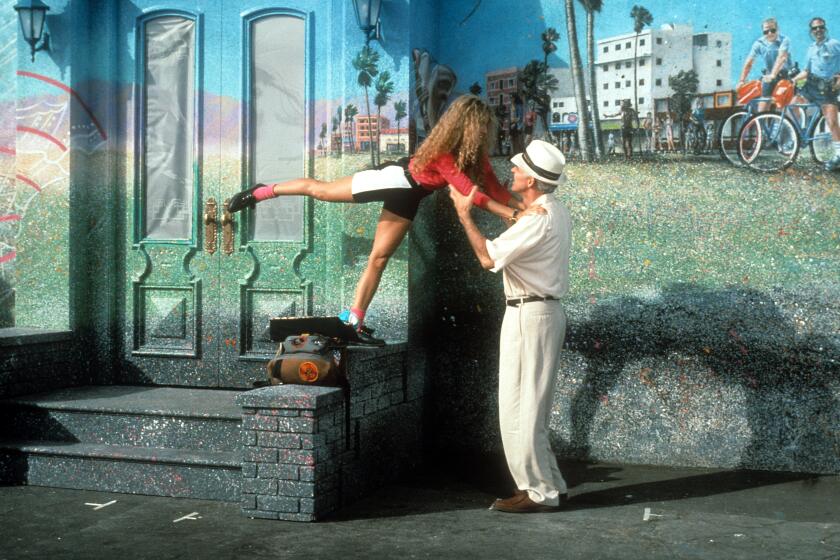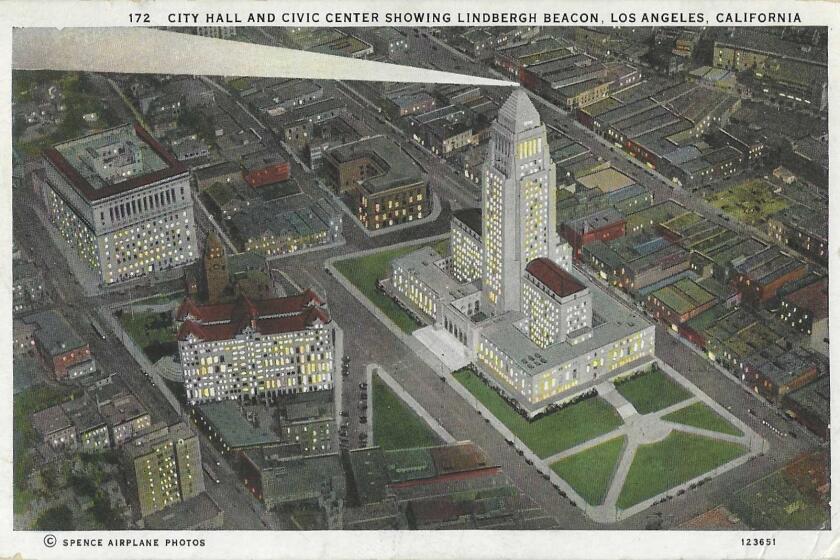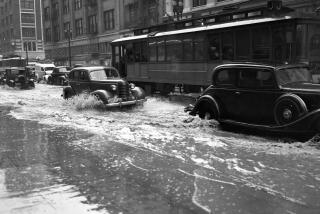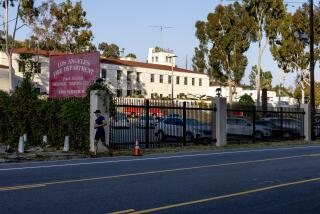Lightning, killer floods and even snow: The real L.A story has weather drama
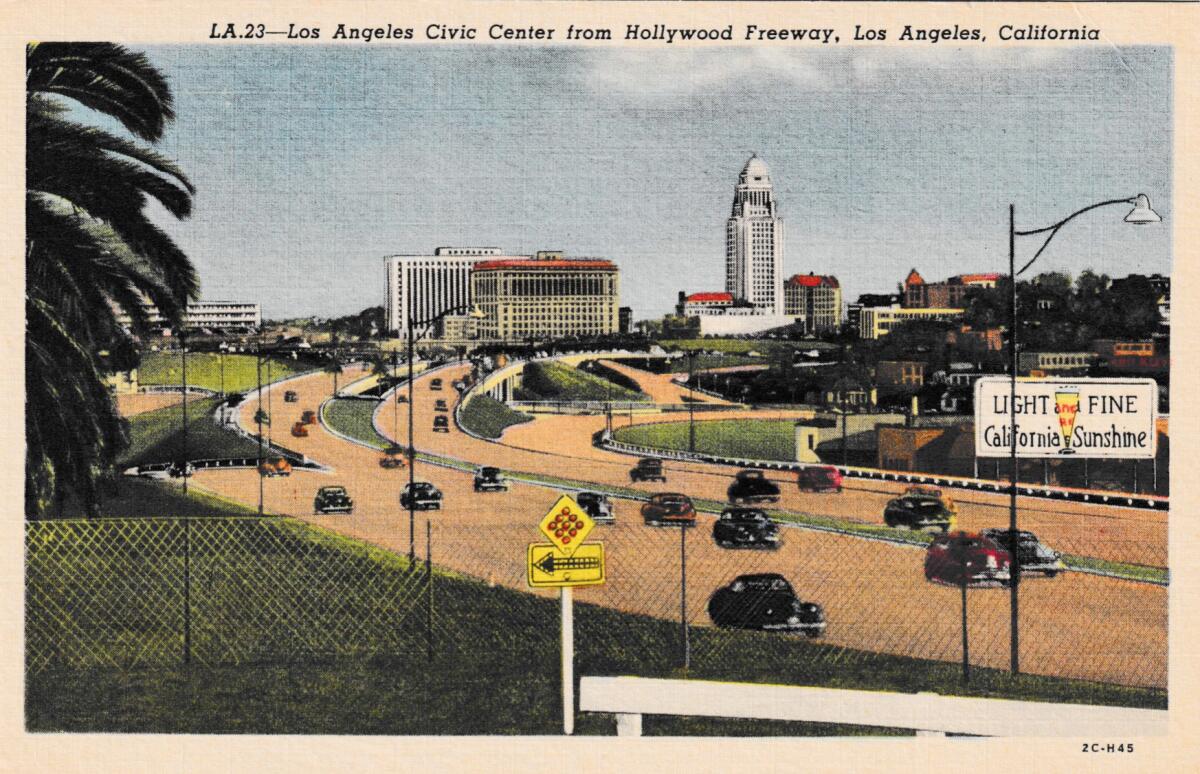
You can’t say it didn’t get your attention, that June lightning storm, thousands upon thousands of seismically intense strikes across Los Angeles. One of them killed a Pico Rivera woman out walking her two dogs. A TV news story shared the odds of being struck by lightning in an eight-decade life: one in 15,300.
For 150 years, L.A. has drunk its own climate-PR Kool-Aid: Temperate! Balmy! A garden! A paradise! Sunshine 730 days a year!
Mostly true — almost always true. No argument here.
But L.A. can be a weather pinball machine: a thing of beauty in repose, but flip the “on” switch, and pow, bang, ding-ding-ding — weather cacophony, more often than you might realize.
As “Los Angeles in the 1930s: the WPA Guide to the City of Angels” put it lyrically — so lyrically, in fact, that you can tell it was written by artists and not bureaucrats — Southern California packs a small nation’s worth of landscape into a few thousand square miles. “It is a region where rugged mountains, cleft by deep gorges, tower in peaks 10,000 feet above sea level; a region of forests and wide deserts, of rolling foothills, fertile valleys, and seasonal rivers that sweep to the sea; a region with craggy shores, strands, capes, bays, and verdant islands washed by the Pacific ocean.”
Explaining L.A. With Patt Morrison
Los Angeles is a complex place. In this weekly feature, Patt Morrison is explaining how it works, its history and its culture.
With all those beaches and oceanfront cliffs, high and low deserts, mountaintops and mountain passes and pop-up rivers — at least a half-dozen microclimates’ worth — turbulent weather can be a surprise, but it shouldn’t be a shock. Harry P. Bailey’s foundational 1966 book “The Climate of Southern California” figures that all this “imported” weather — the winds and rains and thunder and lightning from desert air and cold-origin air and ocean air — brings to Los Angeles “a far greater variety of weather types than would be expected from purely local circumstances.”
So if UCLA and USC really want to join the Big Ten, they can say, with technical veracity, “Hey, Icy Rust Belt guys, we have snow too!”
But not often, and not much. Not since January 1962 has real snow landed and stuck like an Olympic gymnast in the heart of L.A., but as recently as February 2019, there was a Twitter flurry over snow flurries in Malibu and Northridge and a few other spots.
A temperate climate has been more than a selling point for Southern California; it’s been practically a dogma, tediously pleasant weather marketed with a snake-oil hard-sell.
In his poem “New Hampshire,” Robert Frost writes of encountering people from other states. “I met a Californian who would/Talk California – a state so blessed/He said, in climate, none had ever died there/A natural death.…”
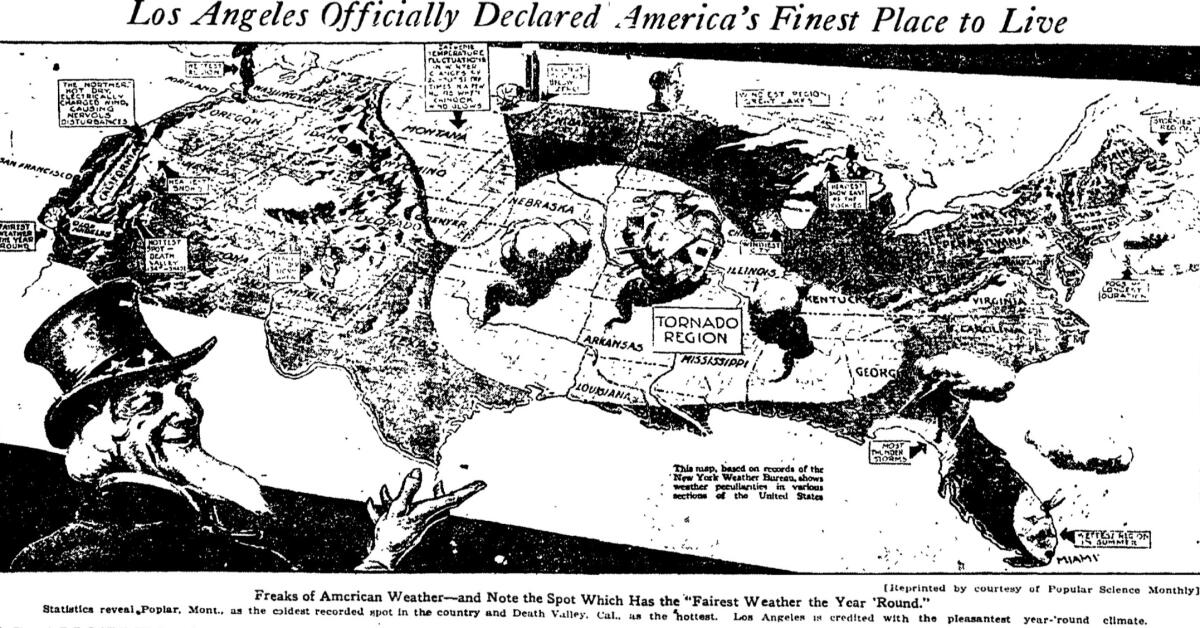
Bob Hope, a native of bleary London who golfed in the eternal sunshine of our spotless greens, maintained files of jokes about contrarian California weather. The actor Monty Woolley was the originator of the quip that only in Southern California could you freeze to death under a blooming rose bush.
When you make a huge deal — as Southern California has — out of no-drama weather, then you get a big dose of something else, like that booming, crackling June thunderstorm, it seems more alarming than it would if we just acknowledged that such weather happens and isn’t always “freak.”
Over and over, The Times has used the word “freak” about weather that defies the Chamber of Commerce storyline, like its July 1918 account of “the freakiest storm that has visited California in more than 20 years.” It was a lightning storm that set fire to oil storage tanks in El Segundo and split an 80-foot pine in Pasadena — dramatic in its effect on humans, sure, but as a storm, maybe not so freaky in and of itself.
Steve Martin’s weatherman character in “L.A. Story” sometimes pre-recorded the changeless, cloudless forecast. Then he got caught out when rain insisted on falling after he foresaw sun-sun-sun. A real L.A. weatherman, Iowa-born and MIT-schooled Kenneth Showalter, said in 1951, with a smidgen of pride that exudes even from the printed page, that we can boast of “the widest day-by-day swings in weather in the nation.” A KABC weatherman named Alan Sloane shared the weatherman’s rule in 1972: “The 11th commandment for any TV weatherman is to take a look outside the studio before going on the air.’’
A vision that blends magical realism, romantic comedy, and even Shakespeare with a voice that could only be Martin’s, “L.A. Story” is finally getting a Blu-ray release Nov. 9, followed by a live table read of the script presented by Film Independent on Nov. 13.
The fourth-highest 24-hour rainfall ever in the continental United States was the unquestionably impressive 25.83 inches unleashed in the San Gabriel Mountains in January 1944, a couple of miles above Sierra Madre. The encircling mountains are a kind of flood-making machine, chuting rain down arroyos and canyons for killer floods, most memorably in 1914, 1934 and 1938.
The death toll of the 1933-34 New Year’s Eve flood has never been accurately tallied, but dozens, certainly, died in the gully-washer that began above Montrose and La Crescenta and roiled its way down to the foothills. Among the dead were twin USC cheerleaders and former child actors Winston and Weston Doty, driving home from a party.
In 1938, another rainfall-induced flood — possibly the result of an early El Nino — submerged miles of L.A. Of more note to the rest of the world, movie stars were marooned on their Valley ranches and in Malibu; the Oscar ceremony was postponed for a week. At least a hundred people died in that one, including 15 who were standing on bridges marveling at the rush of waters when, in a trice, the waters tore away the bridges.
Los Angeles’ mayor, Frank Shaw, silkily told Americans over the radio, “The sun is shining over Southern California today and ... Los Angeles is still smiling.” He was recalled six months later, not for lying about the weather — that was his civic duty — but for corruption.
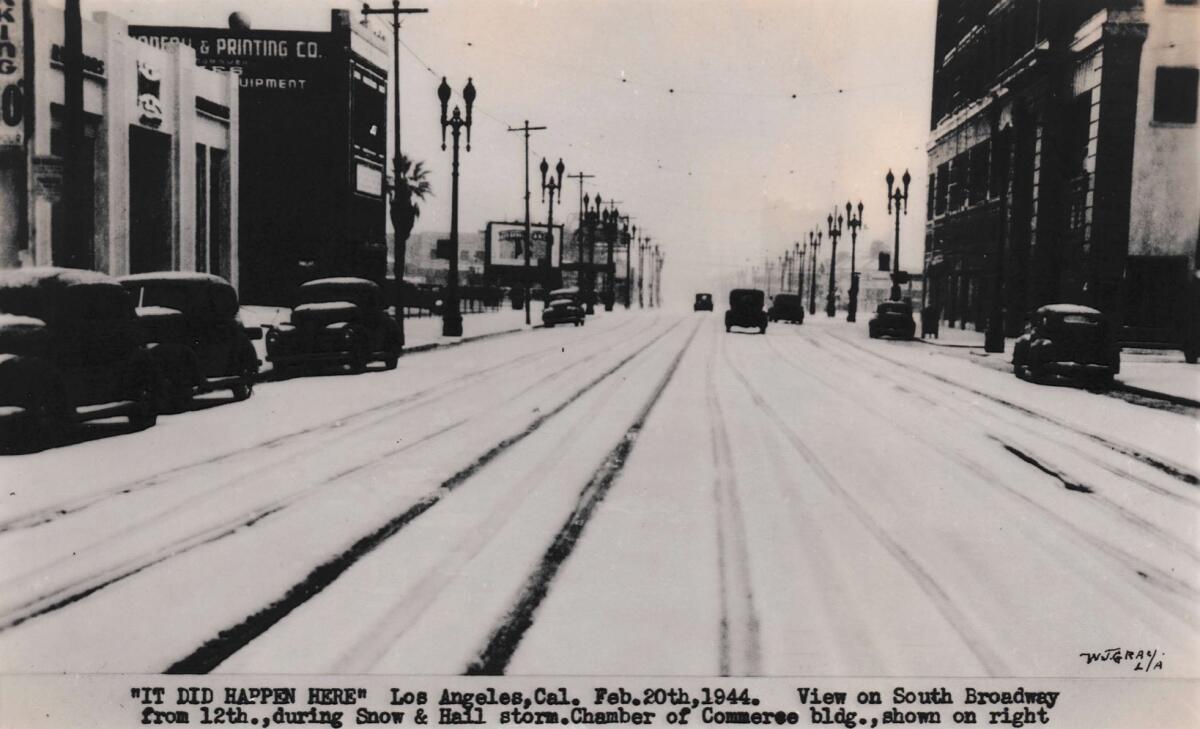
The 1930s was a decade of … let’s call it “abundant weather.”
One year after the Old Testament floods of 1938, rain, hail, thunderstorms, a double rainbow, and snow all at once startled different parts of L.A. Beverly Hills got hail as big as nickels, a comparison that must have insulted its folding-money banlieues.
By September, it was above 100 degrees, and a cloudburst in Riverside County meant 75 workers on a San Jacinto River levee had to be evacuated. Talk about your microclimate: Gilman Hot Springs had five inches of rain in two hours, but some seven miles away, in Hemet, there was hardly enough rain to get the words “It’s raining” out of your mouth before it stopped.
It snowed for almost two hours in January 1932, enough snow for a census of slapdash snowmen to rise up in parts of L.A. A puckishly inclined Van Nuys woman strung sleigh bells on her car.
[Do, please, note that agriculture was a tremendous industry even in Los Angeles County, which until about 1950 was the single most profitable agricultural county in the nation. “Freak” didn’t just mean bemusingly different weather; it could mean the difference between a crop and a crop failure.)
Lightning storms in June 1931 started eight forest fires and hurt four Pomona boys, who were riding their bikes in circles around a big tree in front of the Pomona YMCA when the tree got zapped. Another bolt pierced a three-foot hole in the roof of the San Dimas Orange Growers’ Assn. building and thoughtfully set off the fire alarm.
Thunder, lightning, rain and heavy winds hit as monsoonal moisture moves through the region.
The Santa Ana winds, like apple pie, can come to you as hot or cold, but they always arrive hurtling and whistling. In December 2011 they nudged into Category 2 hurricane numbers, 97 mph sustained wind in the San Gabriel foothills, uprooting trees like so many young carrots at the Los Angeles County Arboretum and the Huntington Library and gardens.
In March 1963, a sandstorm blast of winds at 50 mph forced the Angels and the Houston Colt .45s — two years from a name-change to the Astros — and 7,000 of their fans to leave the field in Palm Springs. The same wide storm system scattered enough snow on Cheviot Hills in West L.A. for snowball fights.
In February 1983, tornadoes and epochal rainstorms drove the visiting queen of England — sovereign of some very soggy isles — off her yacht and onto far-from-dry land here. The same storms sent funnel clouds caroming through South L.A., levitating cars, flipping over mobile homes and prying a hunk of the roof off the Los Angeles Convention Center. It also provided local TV news stations the rare chance to run “Tornado Watch” across our screens.
After the 1932 snowstorm — if a couple of inches can be called that — The Times sought out U.S. weather bureau meteorologist L.H. Daingerfield. He serenely called out our hysteria:
“I’m always a little amused to hear Southern California’s weather called ‘unusual’.… People out here get so accustomed to gentle winds and serene, even-tempered weather that the minute something a little off-schedule happens, like a snow, they begin to shout, ‘This is very unusual!’ The very evenness of our ‘usual’ climate makes even the slightest ‘unusual’ variation noticeable.”
In the meantime, would it kill you to carry an umbrella once in a while?
Los Angeles is a big, complicated place. Patt Morrison explaining how it works, its history and its culture in Explaining L.A. on latimes.com.
More to Read
Sign up for Essential California
The most important California stories and recommendations in your inbox every morning.
You may occasionally receive promotional content from the Los Angeles Times.

